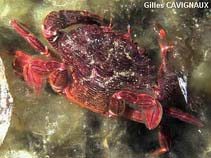Liocarcinus corrugatus (Pennant, 1777)
Wrinkled swimcrab| Native range | All suitable habitat | Point map | Year 2050 |

|
| This map was computer-generated and has not yet been reviewed. |
| Liocarcinus corrugatus AquaMaps Data sources: GBIF OBIS |
Classification / Names Common names | Synonyms | CoL | ITIS | WoRMS
Malacostraca | Decapoda | Polybiidae
Environment: milieu / climate zone / depth range / distribution range Ecology
Benthic; depth range 18 - 60 m (Ref. 435). Subtropical
Distribution Countries | FAO areas | Ecosystems | Occurrences | Introductions
Atlantic, Indo-Pacific and the Mediterranean: from Angola to the British Isles and the Mediterranean, and Japan to Australia and New Zealand (Ref. 435). Anti-tropical (Ref. 84890).
Length at first maturity / Size / Weight / Age
Maturity: Lm ? range ? - ? cm Max length : 5.0 cm CL male/unsexed; (Ref. 435); common length : 2.0 cm CL male/unsexed; (Ref. 435)
Maximum carapace width: 6.0 cm; common carapace width: 2.4 cm (Ref. 435). Minimum depth recorded is 18 m (Ref. 079266).
Life cycle and mating behavior Maturity | Reproduction | Spawning | Eggs | Fecundity | Larvae
Members of the order Decapoda are mostly gonochoric. Mating behavior: Precopulatory courtship ritual is common (through olfactory and tactile cues); usually indirect sperm transfer.
Main reference
References | Coordinator | Collaborators
Fischer, W., G. Bianchi and W.B. Scott (eds.). 1981. (Ref. 435)
IUCN Red List Status (Ref. 130435: Version 2024-1)
CITES status (Ref. 108899)
Not Evaluated
CMS (Ref. 116361)
Not Evaluated
Threat to humans
Human uses
Fisheries: of no interest
| FishSource |
Tools
More information
Trophic Ecology
Ecology
Population dynamics
Life cycle
Distribution
Human Related
Aquaculture profile
Stamps, Coins Misc.
Stamps, Coins Misc.
Outreach
Taxonomy
References
Internet sources
BHL | BOLD Systems | CISTI | DiscoverLife | FAO(Publication : search) | Fishipedia | GenBank (genome, nucleotide) | GloBI | Gomexsi | Google Books | Google Scholar | Google | PubMed | Tree of Life | Wikipedia (Go, Search) | Zoological Record
Estimates based on models
Preferred temperature
(Ref. 115969): 9.9 - 27.6, mean 20.6 (based on 450 cells).
Price category
(Ref. 80766):
Unknown.



